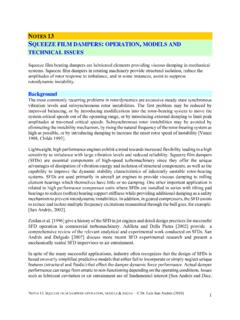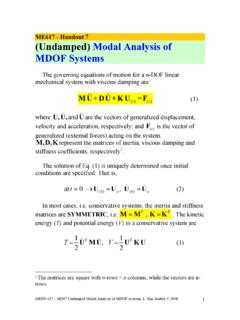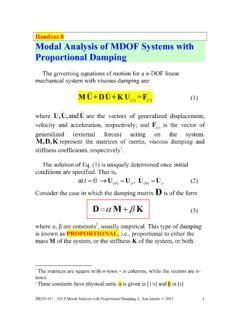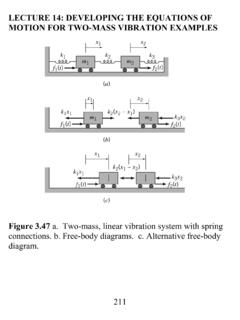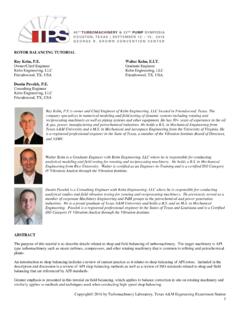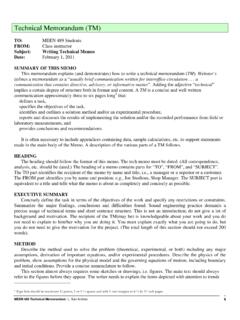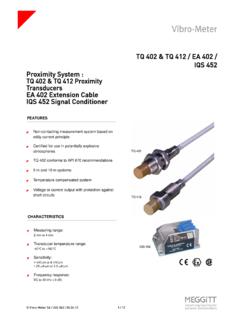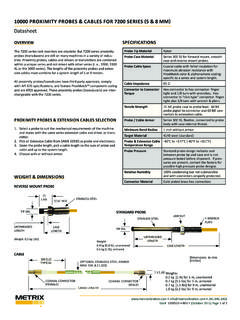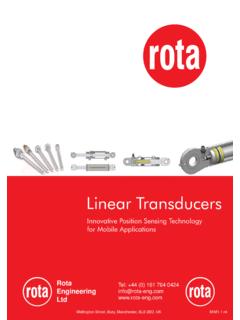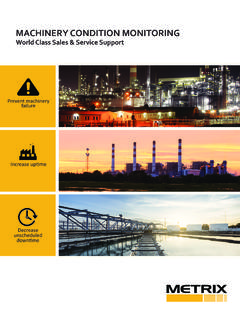Transcription of APPLICATIONS OF VIBRATION TRANSDUCERS
1 Application of VIBRATION Sensor , Dr. Luis San Andr s1 APPLICATIONS OF VIBRATION TRANSDUCERS1) Measurements on Structures or Machinery Casings: Accelerometers andVelocity SensorsUsed in gas turbines, axial compressors, small and mid-size sensors detect high frequency VIBRATION signals related to bearing supports, casingand foundation resonances, VIBRATION in turbine/compressor vanes, defective roller or ballbearings, noise in gears, ) Displacement measurements relative to rotating shafts: Proximity Probes(capacitance or eddy-current)Used in turbomachinery supported on fluid film bearings, centrifugal compressors, gearsand transmissions, electric motors, large pumps (>300HP)
2 , some turbines and sensors detect shaft static displacements, unbalance response, misalignment, shaftbending, excessive loads in bearings, dynamic instabilities, to installSensitive to high frequency noiseGood response at high frequenciesRequire external powerStand high TemperatureRequire electronic integration for velocitySmall size and displacementVELOCITY SENSORSA dvantagesDisadvantagesSimple to installLow resonant frequency & phase shiftGood response in middle range frequenciesCross noiseStand high temperatureBig and heavyDo not require external power Require electronic integration forLowest cost displacementPROXIMITY SENSORSA dvantagesDisadvantagesMeasure static and dynamic displacementsElectrical and mechanical noiseExact response at low frequenciesBounded by
3 High frequenciesNo wearNot calibrated for unknown metal materialsSmall and low costRequire external powerDifficult to installNovel types: OPTICAL FIBERS and LASER BEAMS. Their performance is not well known of VIBRATION Sensor , Dr. Luis San Andr s2 From Reference: Harry N. Norton, Handbook of TRANSDUCERS , Prentice Hall, Chap:5,6,7 VELOCITY SENSORSE lectromagnetic linear velocity TRANSDUCERS : Typically used to measure oscillatory velocity. Apermanent magnet moving back and forth within a coil winding induces an emf in the emf is proportional to the velocity of oscillation of the magnet. This permanent magnet maybe attached to the vibrating object to measure its tachometer generators: Used to measure the angular velocity of vibratingobjects.
4 They provide an output voltage/frequency that is proportional to the angular tachometers use a permanent magnet or magneto, while the AC tachometers operate as avariable coupling transformer, with the coupling coefficient proportional to the rotary SENSORSC apacitive accelerometers: Used generally in those that have diaphragm supported seismicmass as a moving electrode and one/two fixed electrodes. The signal generated due to change incapacitance is post-processed using LC circuits etc., to output a measurable accelerometers: Acceleration acting on a seismic mass exerts a force on thepiezoelectric crystals, which then produce a proportional electric charge.
5 The piezoelectriccrystals are usually preloaded so that either an increase or decrease in acceleration causes achange in the charge produced by them. But they are not reliable at very low accelerometers: Relatively cheap and used where slowly varying acceleration isto be measured with a fair amount of accuracy. In these, the displacement of a spring masssystem is mechanically linked to a viper arm, which moves along a potentiometric resistiveelement. Various designs may have either viscous, magnetic or gas accelerometers: They compose accelerometers of the differential transformer type orthe inductance bridge type.
6 The AC outputs of these vary in phase as well as amplitude. They areconverted into DC by means of a phase-sensitive accelerometers: These use the closed loop servo systems of force-balance, torque-balanceor null-balance to provide close accuracy. Acceleration causes a seismic mass to move. Themotion is detected by one of the motion-detection devices, which generate a signal that acts as anerror signal in the servo-loop. The demodulated and amplified signal is then passed through apassive damping network and then applied to the torquing coil located at the axis of rotation ofthe mass.
7 The torque is proportional to the coil current, which is in turn proportional to Gage accelerators: these can be made very small in size and mass. The displacement ofthe spring-mass system is converted into a change in resistance, due to strain, in four arms of aWheatstone bridge. The signal is then post-processed to read the A Few Sensor Types Used for VIBRATION Measurements 1A FEW SENSOR TYPES USED FOR COMMON VIBRATION MEASUREMENTS Disclaimer: The material in this document was copied ad verbatim from the sources noted. Its accuracy can not be warranted. 1) Accelerometers (piezoelectric) 2) Velocity Sensor 3) Proximity Probes (capacitance or eddy current) 4) Laser displacement sensors 1) ACCELEROMETERS REFERENCE: An accelerometer is a device that measures the VIBRATION , or acceleration of motion of a structure.
8 The force caused by VIBRATION or a change in motion (acceleration) causes the mass to "squeeze" the piezoelectric material which produces an electrical charge that is proportional to the force exerted upon it. Since the charge is proportional to the force, and the mass is a constant, then the charge is also proportional to the acceleration. There are two types of piezoelectric accelerometers ( VIBRATION sensors). The first type is a "high impedance" charge output accelerometer. In this type of accelerometer the piezoelectric crystal produces an electrical charge which is connected directly to the measurement instruments.
9 This type of accelerometer is also used in high temperature APPLICATIONS (>120C) where low impedance models cannot be used. The second type of accelerometer is a low impedance output accelerometer. A low impedance accelerometer has a charge accelerometer as its front end but has a tiny built-in micro-circuit and FET transistor that converts that charge into a low impedance voltage that can easily interface with standard instrumentation. Piezoelectric Accelerometers Reference : ME617 A Few Sensor Types Used for VIBRATION Measurements 2 Piezoelectric accelerometers rely on the piezoelectric effect of quartz or ceramic crystals to generate an electrical output that is proportional to applied acceleration.
10 The piezoelectric effect produces an opposed accumulation of charged particles on the crystal. This charge is proportional to applied force or stress. A force applied to a quartz crystal lattice structure alters alignment of positive and negative ions, which results in an accumulation of these charged ions on opposed surfaces. These charged ions accumulate on an electrode that is ultimately conditioned by transistor microelectronics. In an accelerometer, the stress on the crystals occurs as a result of the seismic mass imposing a force on the crystal. Over its specified frequency range, this structure approximately obeys Newton's law of motion, F=ma.
